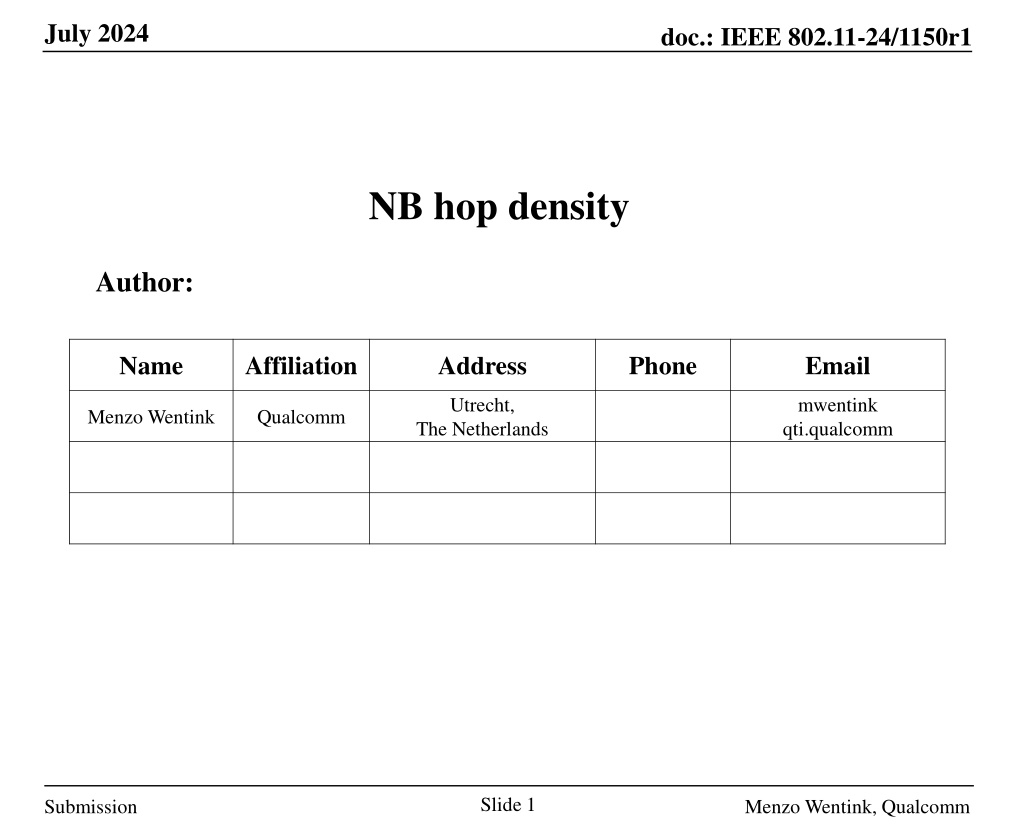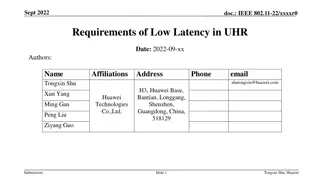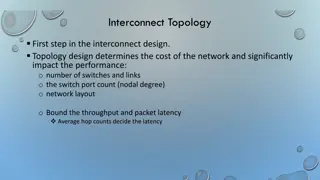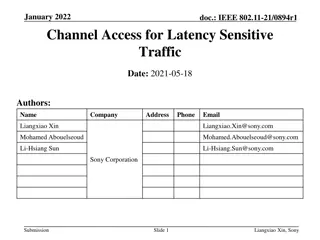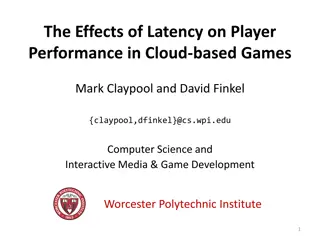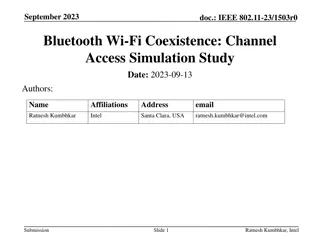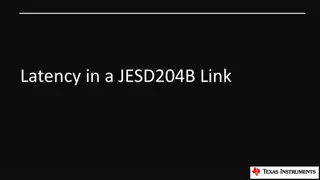Understanding the Relationship Between Hop Density and Wi-Fi Channel Access Latency
These slides explore the impact of hop density on Wi-Fi channel access latency, focusing on the challenges arising from partially overlapping NB transmissions. Strategies to control NB duty cycle and dynamic adaptations to mitigate interference with Wi-Fi signals are discussed, offering insights into improving frequency separation and reducing overall Bluetooth duty cycle.
Download Presentation

Please find below an Image/Link to download the presentation.
The content on the website is provided AS IS for your information and personal use only. It may not be sold, licensed, or shared on other websites without obtaining consent from the author. Download presentation by click this link. If you encounter any issues during the download, it is possible that the publisher has removed the file from their server.
E N D
Presentation Transcript
July 2024 doc.: IEEE 802.11-24/1150r1 NB hop density Author: Name Affiliation Address Phone Email Utrecht, mwentink qti.qualcomm Menzo Wentink Qualcomm The Netherlands Slide 1 Submission Menzo Wentink, Qualcomm
July 2024 doc.: IEEE 802.11-24/1150r1 Introduction These slides provide some examples on the relation between hop density and Wi-Fi channel access latency Increased hop density causes more partially overlapping NB transmissions, which makes it harder for Wi-Fi to find 20/40/80/160/etc. MHz spectrum that is idle all at the same time Possible methods are illustrated to (dynamically) control the NB duty cycle (DC) maximum DC per 20 MHz dynamic DC per 20 MHz these could be complemented with a dynamic EDT increase on repeated CCA busy at NB, so that neither Wi-Fi nor NB will be able to capture the medium entirely when both are confined in the same limited spectrum when sufficient spectrum is available, neither dynamic duty cycle adaptation nor dynamic EDT adaptation are expected to trigger much This analysis mainly relates to ACL traffic, where the duty cycle can be very high Slide 2 Submission Menzo Wentink, Qualcomm
July 2024 doc.: IEEE 802.11-24/1150r1 Maximum DC per 20 MHz NB uses a maximum DC per 20 MHz segment max 3.7% DC per 20 MHz, which adds up to 88% over 480 MHz the maximum DC could depend on the NB PSD, which would allow for a higher segment DC for lower PSD (or Tx power) Slide 3 Submission Menzo Wentink, Qualcomm
July 2024 doc.: IEEE 802.11-24/1150r1 Dynamic DC adaptation With dynamic DC adaptation, the Bluetooth central reduces the Tx time in a given 20 MHz segment from 6377 us to 360 us (per 7.5 ms) after a CCA busy occurs in the segment, until 10 CCA idles have occurred in the segment effectively, the duty cycle in that segment is temporarily reduced from 3.6% to 0.3% transmissions in the segment can continue after the CCA busy, but with a shorter Tx time transmissions in other segments are not affected (except when a CCA busy occurs there too) This causes that the overall Bluetooth duty cycle is reduced based on NB-NB collisions the NB-NB collision rate is typically low, so this mechanism only becomes active when there are many high duty cycle NB links in a relatively small portion of the spectrum the impact is distributed relatively fairly over all nodes this also causes that the NB duty cycle is reduced in the part of the spectrum where Wi-Fi is active, which improves frequency separation There is no impact on ISO audio, because the Tx time is already 360 us Other methods to achieve the same may be possible, e.g. the DC reduction could set in after a delay the DC reduction could depend on the PSD (i.e. longer TXOPs at lower PSD) etc. Slide 4 Submission Menzo Wentink, Qualcomm
July 2024 doc.: IEEE 802.11-24/1150r1 Topology Slide 5 Submission Menzo Wentink, Qualcomm
July 2024 doc.: IEEE 802.11-24/1150r1 Topology 8 6 4 2 y (m) 0 -2 -4 -6 -8 -2 0 2 4 6 8 10 12 x (m) nb_r8200c Slide 6 Submission Menzo Wentink, Qualcomm
July 2024 doc.: IEEE 802.11-24/1150r1 Sims Slide 7 Submission Menzo Wentink, Qualcomm
July 2024 doc.: IEEE 802.11-24/1150r1 Baseline The hop density in the upper part increases after Wi-Fi starts, due to the SCD BT hops in 480 MHz 88% duty cycle per link (ACL with 6377 us data packet length in a 7500 us period) Wi-Fi starts here Wi-Fi uses static BW in 160 MHz nb_r8200c Slide 8 Submission Menzo Wentink, Qualcomm
July 2024 doc.: IEEE 802.11-24/1150r1 Max DC/20 MHz The hop density in the upper part stays relatively the same BT hops in 480 MHz 88% duty cycle per link (ACL with 6377 us data packet length in a 7500 us period) Wi-Fi starts here Wi-Fi uses static BW in 160 MHz nb_r8201c Slide 9 Submission Menzo Wentink, Qualcomm
July 2024 doc.: IEEE 802.11-24/1150r1 Dynamic DC/20 MHz The hop density in the upper part stays relatively the same BT hops in 480 MHz 88% duty cycle per link (ACL with 6377 us data packet length in a 7500 us period) Wi-Fi starts here Wi-Fi uses static BW in 160 MHz nb_r8204c Slide 10 Submission Menzo Wentink, Qualcomm
July 2024 doc.: IEEE 802.11-24/1150r1 Zoomed plots Slide 11 Submission Menzo Wentink, Qualcomm
July 2024 doc.: IEEE 802.11-24/1150r1 Baseline The hop density in the upper part increases after Wi-Fi starts, due to the SCD BT hops in 480 MHz 88% duty cycle per link (ACL with 6377 us data packet length in a 7500 us period) Wi-Fi starts here Wi-Fi uses static BW in 160 MHz nb_r8200c Slide 12 Submission Menzo Wentink, Qualcomm
July 2024 doc.: IEEE 802.11-24/1150r1 Max DC/20 MHz The hop density in the upper part stays relatively the same BT hops in 480 MHz 88% duty cycle per link (ACL with 6377 us data packet length in a 7500 us period) Wi-Fi starts here Wi-Fi uses static BW in 160 MHz nb_r8201c Slide 13 Submission Menzo Wentink, Qualcomm
July 2024 doc.: IEEE 802.11-24/1150r1 Dynamic DC/20 MHz The hop density in the upper part stays relatively the same BT hops in 480 MHz 88% duty cycle per link (ACL with 6377 us data packet length in a 7500 us period) Wi-Fi starts here Wi-Fi uses static BW in 160 MHz nb_r8204c Slide 14 Submission Menzo Wentink, Qualcomm
July 2024 doc.: IEEE 802.11-24/1150r1 CCA busy time distributions Slide 15 Submission Menzo Wentink, Qualcomm
July 2024 doc.: IEEE 802.11-24/1150r1 Baseline CCA busy time per CCA segment (CDF) 1 Wi-Fi channel 0.98 160 MHz segments where Wi-Fi is not active 0.96 0.94 0.92 CDF The 160 MHz CCA busy probability is high both on the Wi-Fi channel and the segments where Wi-Fi is not currently active. The latency is caused by partially overlapping NB transmissions 0.9 0.88 0.86 0.84 0.82 0.8 0 50 100 150 200 250 300 CCA busy time (ms) nb_r8310a Slide 16 Submission Menzo Wentink, Qualcomm
July 2024 doc.: IEEE 802.11-24/1150r1 Max DC/20 MHz CCA busy time per CCA segment (CDF) 1 0.98 Wi-Fi channel 160 MHz segments where Wi-Fi is not active 0.96 0.94 0.92 CDF The 160 MHz CCA busy probability is improved but still high. The Wi-Fi channel is slightly worse somehow 0.9 0.88 0.86 0.84 0.82 0.8 0 50 100 150 200 250 300 CCA busy time (ms) nb_r8311a Slide 17 Submission Menzo Wentink, Qualcomm
July 2024 doc.: IEEE 802.11-24/1150r1 Dynamic DC/20 MHz (10 CCA idles required) CCA busy time per CCA segment (CDF) 1 Wi-Fi channel 0.98 160 MHz segments where Wi-Fi is not active 0.96 0.94 0.92 CDF The 160 MHz CCA busy probability is low on the Wi-Fi channel and reduced on the segments where Wi- Fi is not currently active 0.9 0.88 0.86 0.84 0.82 0.8 0 50 100 150 200 250 300 CCA busy time (ms) nb_r8312a Slide 18 Submission Menzo Wentink, Qualcomm
July 2024 doc.: IEEE 802.11-24/1150r1 Dynamic DC/20 MHz (50 CCA idles required) Wi-Fi channel CCA busy time per CCA segment (CDF) 1 0.98 160 MHz segments where Wi-Fi is not active 0.96 0.94 0.92 CDF The 160 MHz CCA busy probability is low on the Wi-Fi channel and further reduced on the segments where Wi-Fi is not currently active 0.9 0.88 0.86 0.84 0.82 0.8 0 50 100 150 200 250 300 CCA busy time (ms) nb_r8313a Slide 19 Submission Menzo Wentink, Qualcomm
July 2024 doc.: IEEE 802.11-24/1150r1 BRAN(24)124020 results for 160 MHz (Sebastian Max) BRAN(24)124020 Slide 20 Submission Menzo Wentink, Qualcomm
